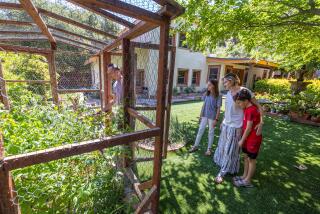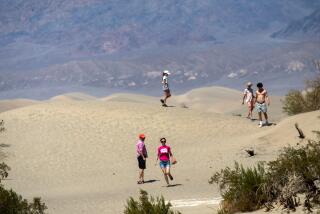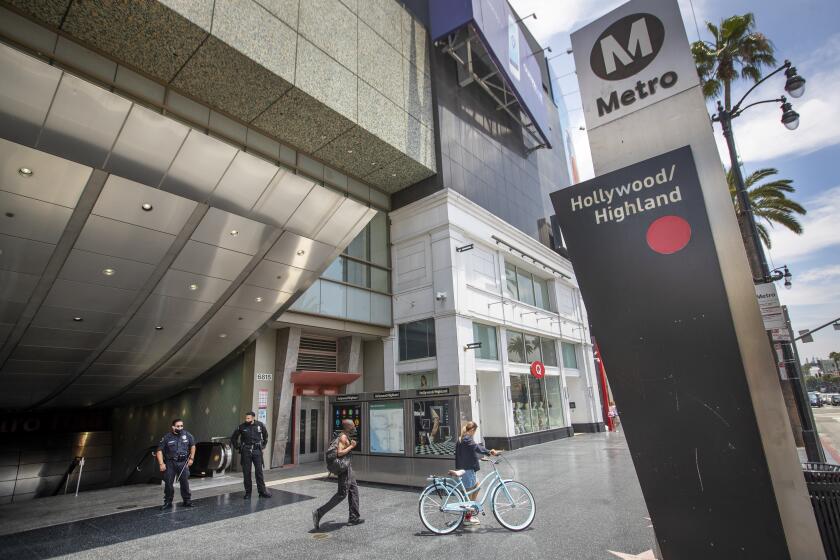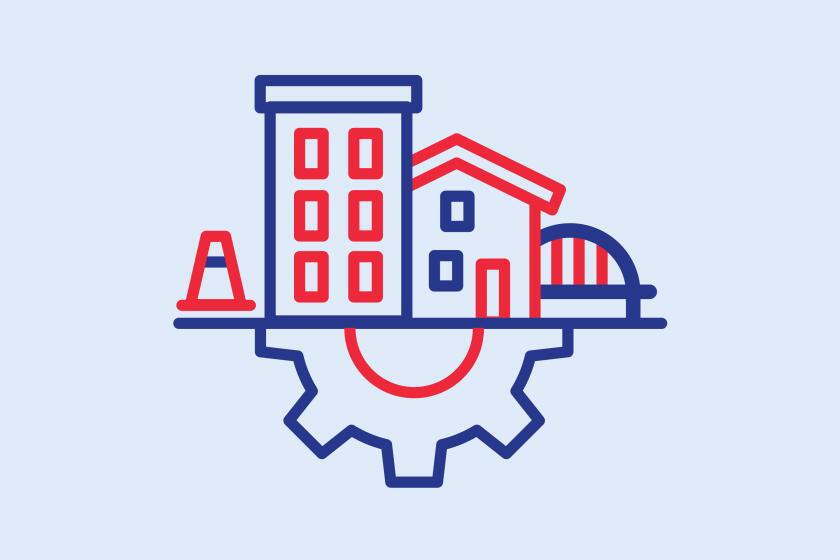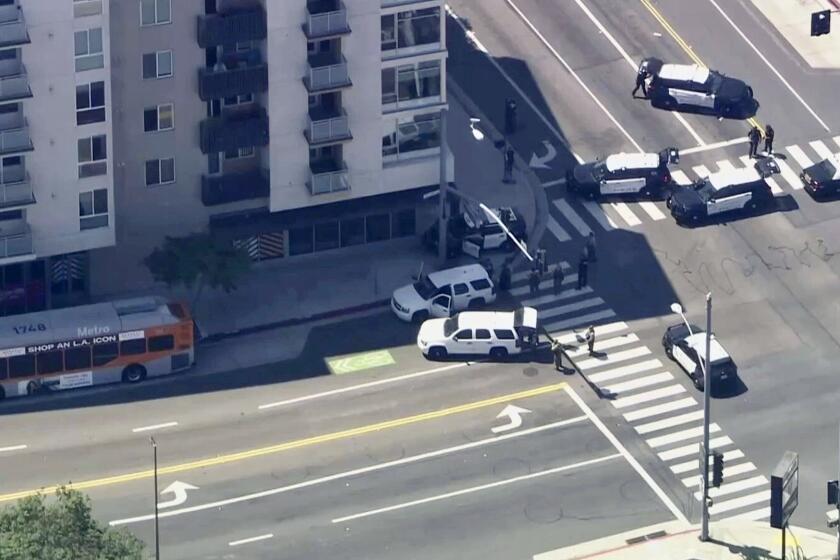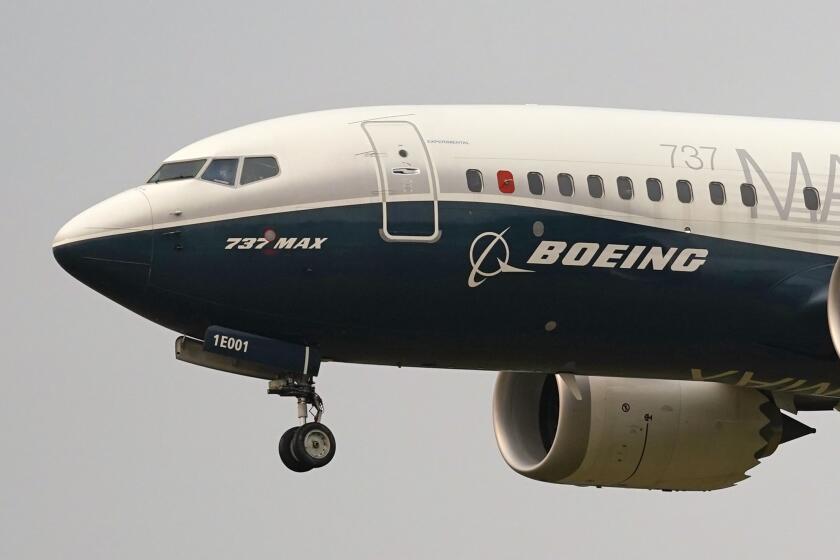Freeway a Mess? Stop and Take a Look at Yourself
A gray Mazda pulled over for speeding on the northbound Santa Ana Freeway at Whittier Boulevard: just a ticket, but one of the state’s major north-south arteries has crawled to a standstill.
A fender bender between a car and a truck on the Hollywood-Santa Monica freeway interchange: nothing more than a scratch, but traffic has slowed to 10 mph in both directions.
A cat, trying to cross the freeway, is trapped at the center divider of the southbound Harbor Freeway at 51st Avenue. The feline in search of a safe haven has caused humans delays in both directions.
The key to making a minor roadway incident into a major traffic jam? Call it the “looky-loo” syndrome: motorists who cannot resist the urge to stare--at a strange event on the freeway, an accident or even a fellow commuter caught in the snare of the California Highway Patrol.
They turn, watch the commotion, silently thank the stars that they weren’t involved--and, at the same time, ease their feet off the collective gas pedal to take a longer look.
Slowdown, and more congested traffic, result.
Looky-loos are a major culprit in clogged freeways, according to James E. Moore, a USC professor of civil engineering and public policy and associate director for the National Center for Metropolitan Transportation Research.
“We have about as big a problem with incidents as with accidents because of the gawking effect,” says Moore, who studies Southern California’s traffic patterns. “Any time there is an accident within the line of sight of drivers, there’s a loss of freeway capacity.”
Statistics from the California Department of Transportation indicate that rubbernecking alone can contribute to freeway capacity reductions of up to 26%, whenever an accident or CHP stop is visible to passing motorists.
Looky-loos are enough of a problem that researchers at USC’s Center for Transportation Technology have developed a mathematical equation to predict the extent of the traffic shock wave generated by slowing motorists.
The challenge, for law enforcement and motorists alike, is how to prevent traffic incidents from causing major traffic snares.
“Fifty percent of traffic congestion is related to incidents on the freeways like accidents and other things that block lanes or bother drivers,” says Steve Finnegan of the Automobile Club of Southern California. “To the extent that we can move those things out of view, that will be an improvement to congestion.”
Whether it’s a solo spin-out or a two-vehicle collision, an illegal lane changer or a speeding motorist, law-enforcement officers are trained to move both fender-benders and traffic offenders off the freeway as efficiently as possible.
Officer Frank Sandoval of the CHP’s Southern Division can recite the procedure as if by rote:
“Usually when we stop somebody, we will get behind you, turn on the red lights and get you off the freeway or pull you off the shoulder. We activate our rear flashing amber lights before we turn on the red lights to alert drivers behind us to slow down and give us a cushion space. We will then guide the violator over to the right. Or, if it’s approximate to an offramp, we will tell you to go ahead and take the exit.”
For fender-benders, Sandoval adds, “we do the same thing as with a traffic violation.” He stresses that minor traffic accidents do not need to be discussed and investigated in a traffic lane. Preserving an accident scene is unnecessary when no one has been injured.
Motorists should carefully maneuver to the right shoulder, exit the freeway altogether or, where possible, use the accident investigation sites along the sides of many Southland freeways.
More than a dozen such sites--scattered between the San Diego, Harbor and Santa Monica freeways--allow motorists to pull off a freeway, use a call box or talk with others involved in an accident. The sites provide not only a safe haven for hashing out the details of an accident, their fencing puts them mostly out of sight of motorists.
“The best thing would be to continue driving and not try to look,” says Finnegan of the Auto Club, “but that’s hard for people to do.”
The accident investigation sites along the Santa Monica Freeway seem little used by motorists--although no studies have been done to assess their effectiveness since they were created in 1993.
But, in cases where accident investigation sites are not available, the CHP and other law enforcement agencies must rely on a variety of programs to alleviate congestion as quickly and as efficiently as possible.
At a downtown Los Angeles transportation management center, staffed 24 hours a day by representatives of Caltrans and the CHP, officers and state officials watch cameras installed at key congestion points across the region’s vast freeway network. They also monitor “loop detectors,” embedded every half-mile in freeway pavement, to help them recognize unusual traffic patterns.
The traffic managers can then call for officers to help disabled cars off the roads, put traffic advisories onto freeway message signs and communicate with television and radio stations’ traffic reporters, who can broadcast alternative routes.
In addition, CHP air operations--with airplanes and helicopters--patrol the skies above freeways to give officers information about traffic snarls, and to dispatch cars to the scene, often before an accident is called in by motorists.
And, in what transportation experts have said is one of the most effective tactics for clearing the roadways, the Metro Freeway Service Patrol supplies a fleet of roving tow trucks to quickly remove disabled cars from Los Angeles County freeways.
Cars have been removed in an average of five minutes instead of 20 minutes, according to one study of the patrol, which is a joint project of the Metropolitan Transportation Authority, CHP and Caltrans.
When all else fails, CHP officers sometimes clear snarled freeways the old-fashioned way--standing at roadside and windmilling their arms to urge cars to keep moving.
Earlier this month, a fatal accident on the Hollywood Freeway at 4 a.m. caused a massive ripple effect in traffic--due largely to looky-loos--that lasted almost six hours. Traffic was “messed up for miles in every direction,” according to Officer Scott Ellison of the CHP’s Central Division.
Delays were reported on every freeway that connects with the 101, and some that do not, including the Foothill Freeway, where drivers looking for an alternative route were blamed for bringing westbound traffic to a standstill.
CHP officers were dispatched to both sides of the 101 to wave traffic on. “Because of the looky-loo problem, we had to post officers on both sides of the freeway,” Ellison said. “These officers were out there getting some serious exercise, waving their arms. It’s all hand motions, just waving them through. When people almost come to a standstill because of an accident, sometimes we have to wake them up. I think it helps--how much, who knows. At least traffic is just moving, and not at a standstill. Even if it’s just 15 miles an hour.”
*
If you have questions, comments or story ideas regarding driving or traffic in Southern California, send an e-mail to behindthewheel@latimes.com.
More to Read
Start your day right
Sign up for Essential California for news, features and recommendations from the L.A. Times and beyond in your inbox six days a week.
You may occasionally receive promotional content from the Los Angeles Times.

